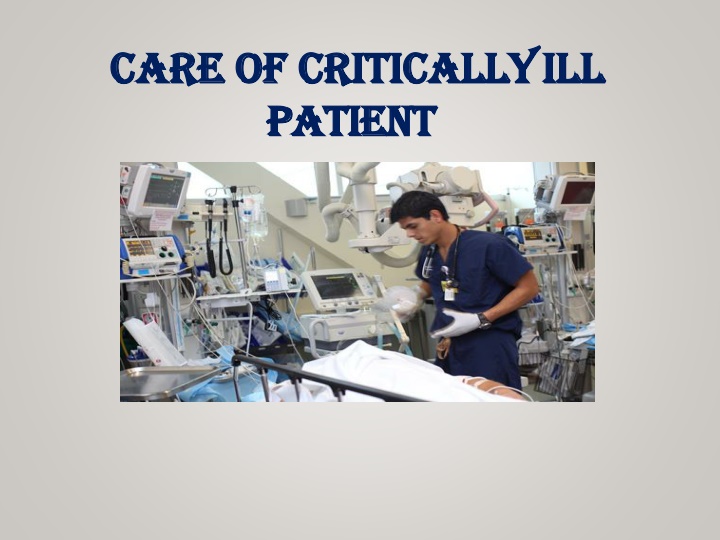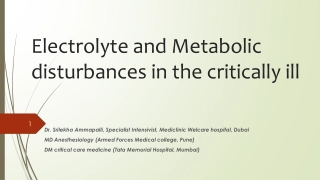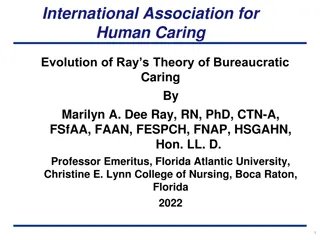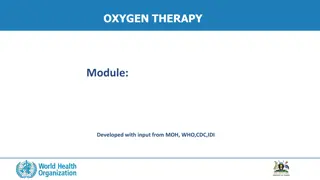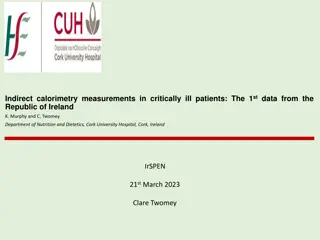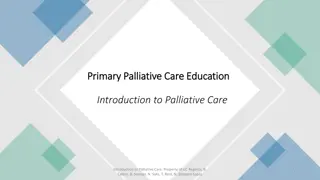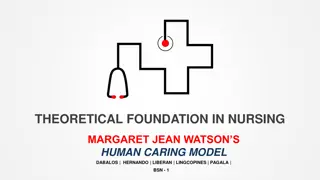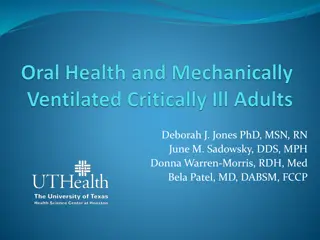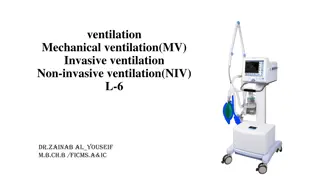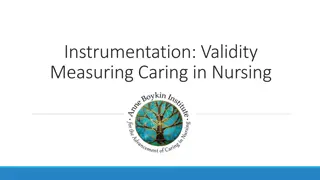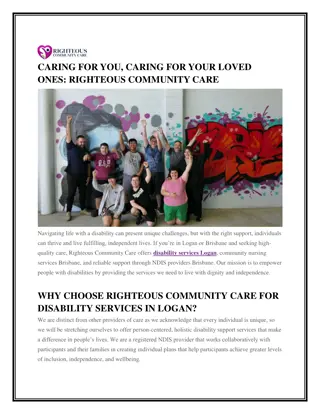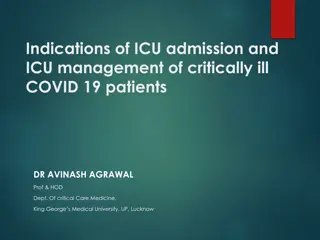Caring for Critically Ill Patients
Providing quality care for critically ill patients is crucial for their recovery and well-being. This involves constant monitoring, timely interventions, and compassionate support. Healthcare professionals in critical care units strive to stabilize patients, manage their conditions, and improve outcomes. Effective communication, teamwork, and expertise are essential in this challenging but rewarding environment. Understanding the unique needs of each critically ill patient and addressing them with skill and empathy make a significant difference in their journey to recovery.
Download Presentation

Please find below an Image/Link to download the presentation.
The content on the website is provided AS IS for your information and personal use only. It may not be sold, licensed, or shared on other websites without obtaining consent from the author.If you encounter any issues during the download, it is possible that the publisher has removed the file from their server.
You are allowed to download the files provided on this website for personal or commercial use, subject to the condition that they are used lawfully. All files are the property of their respective owners.
The content on the website is provided AS IS for your information and personal use only. It may not be sold, licensed, or shared on other websites without obtaining consent from the author.
E N D
Presentation Transcript
CARE OF CARE OF CRITICALLY CRITICALLY ILL PATIENT PATIENT ILL
INTRODUCTION Critical care nursing: It is the field of nursing with a focus on the utmost care of the critically ill patient or the family. Critically ill patients : critically ill patients are those who are at risk for actual (or) potential problems. unstable patients. life threatening health
Guiding principles: Delivery of optimal and appropriate care . Relief of distress Compassion and support Dignity Information Rehabilitation Care and support of relatives and care givers.
CLASSIFICATION OF CCU PATIENTS Level 0: Normal acute ward care Level 1:(General at risk ward pt s) a) Acute ward care, with additional advice and support from the critical care team eg patients who are at risk of deterioration, or b) Who are recovering after higher levels of care and still have great nursing needs
Level 2:(High Dependency) Detailed observation or intervention eg patients with a single failing organ system, or post-operative patients, or patients stepping down from higher levels of care Level 3:(Intensive Care) Advanced respiratory support alone, or basic respiratory support together with support of at least two organ systems
Management of Patients critically ill Complete monitoring Respiratory care Cardio vascular care Gastrointestinal Nutritional care Neuro muscular Comfort and reassurance Communication patient Venous prophylaxis with the thrombosis
Infection control skin care General hygiene and mouth care Fluid, electrolyte and glucose balance Bladder care Dressing and wound care Communication with relatives
ASSESSMENT AND CLINICAL EXAMINATION A: airway B: breathing C: circulation D: disability E: exposure
Respiratory care Patient may have: Airway obstruction Altered ventilation Poor secretion clearance Atelectasis(lung collapse) Impaired muscle function. Management Respiratory care includes: Assisting in coughing. Deep Breathing. Chest Percussion. Positioning(Fowlers Position) Bronchodilators. Suctioning. (q4h) or if neccesary Tracheostomy care.
Cardio vascular care: Prolonged immobility impairs autonomic vasomotor responses to sitting and standing causing profound postural hypotension. tilt table may be beneficial prior to mobilization. Dvt prophylaxis Gastro intestinal/ nutritional care;: The supine position predisposes to gastro oesophageal reflux and aspiration pneumonia .Keep head end elevated to 30 degrees. Early enteral feeding reduces infection, stress ulceration and GI bleeding. Immobility is associated with gastric stasis and constipation, gastric stimulants and laxatives are essential.
Neuromuscular care Immobility, prolonged neuro muscular blockage and sedation promotes atropy. Joint contractures and foot drops may occur. Physiotherapy and splints may be required.
GLASGOW COMA SCALE The Glasgow coma scale or GCS is a neurological scale that aims to give a reliable , objective way of recording the consciousness state of a person for initial as well as subsequent assessment. GCS was initially used to assess level of consciousness after head injury. In hospitals it is also used in monitoring chronic patients in intensive care . Compassionate care of relatives is always appreciated, avoids anger and is one of the best indicators of a well- functioning units. Each activity about the patient should be informed to the relatives and explained according to their knowledge level and informed consent must be obtained.
Comfort and reassurance Anxiety, discomfort and pain must be recognized and relieved with reassurance, physical measures, analgesics and sedatives. In particular, endotracheal or nasogastric tubes, bladder or bowel distension, inflamed line sites ,painful joints and urinary catheters often causes discomfort, and are often overlooked. Fan use is controversial as dust- borne micro- organisms may be disseminated. Visible clocks helps patients maintain circadian rhythms(i.e. day- night patterns). Communication with the patient use of amnesic drugs makes repeated explanations and reassurance essential. assist intraction with appropriate communication aids.
Venous thrombosis prophylaxis Venous thrombosis prophylaxis : trauma , sepsis , surgery and immobility predisposes to lower limb thrombosis. Mechanical and pharmacological prophylaxis prevents potentially life threatening pulmonary embolism. Infection control Hand washing is vital to prevent transmission of organisms between patients. disposable aprons are recommended. sterile technique (e.g. gloves, masks, gowns, sterile field) is essential for all invasive procedures(e.g. line insertion). Isolation(+ or ve pressure ventilation) for transmissible infections (e.g. tuberculosis) thorough cleaning of bed spaces(e.g. routinely and after patient discharge).
Skin care, general hygiene and mouth care Cutaneous pressure sores are due to local pressure(e.g. bony malnutrition, edema, ischemic damage related to moist or soiled skin. Turn patient every 2 hours and protect susceptible areas. Special beds relieves pressure and assist turning. Mouth care and general hygiene is essential. Fluid electrolytes and glucose balance Regularly assess fluid and electrolytes balance. Insulin resistence and hyperglycaemia are common but maintaining normo-glycaemia improves outcomes. prominences). friction
Bladder care Urinary catheters causes painful urethral ulcers and must be stabilized. Early removal reduces urinary tract infections. Dressing and wound care Replace wound dressings as necessary. Change arterial and central venous catheter dressings every 48- 72 hours. Communication with relatives Family members receive information from many care givers with different perspectives and knowledge. Critical care teams must aim to be consistent in their assessments and honest about uncertainties. All conversation should be documented.
ANXIETY The primary sources of anxiety for patients include the perceived or anticipated threat to physical health, actual loss of control or body functions, and an environment that is foreign. Assessing patients for anxiety is very important and clinical indicators can include agitation, increased blood pressure, increased heart rate, patient verbalization of anxiety, and restlessness. To help reduce anxiety, the nurse should encourage patients and families to express concerns, ask questions, and state their needs; and include the patient and family in all conversations and explain the purpose of equipment and procedures. Antianxiety drugs and complementary therapies may reduce the stress response and should be considered.
PAIN The control of pain in the ICU patient is paramount as inadequate pain control is often linked with agitation and anxiety and can contribute to the stress response. ICU patients at high risk for pain include patients: (1) who have medical conditions that include ischemic, infectious, or inflammatory processes. (2) who are immobilized. (3) who have invasive monitoring devices, including endotracheal tubes. (4) who are scheduled for any invasive or noninvasive procedures.
DELIRIUM Sudden onset of disturbances in cognition, attention, and perception. Manifest as hyperactive, hypoactive, or mixed. Mixed type is most prevalent in ICU. Delirium in ICU patients ranges from 15% to 40%. Demographic factors predisposing the patient to delirium include Advanced age, Pre existing cerebral illnesses Environmental factors that can contribute to delirium include sleep deprivation, anxiety, sensory overload, and immobilization. Physical conditions such as hemodynamic instability, hypoxemia, hypercarbia, electrolyte disturbances, and severe infections can precipitate delirium. Certain drugs (e.g sedatives, furosemide, antimicrobials) have been associated with the development of delirium.
MANAGEMENT OFDELIRIUM The ICU nurse must identify predisposing factors that may precipitate delirium and improve the patient s mental clarity and cooperation with appropriate therapy (e.g., correction of oxygenation, use of clocks and calendars). If the patient demonstrates unsafe behavior, hyperactivity, insomnia, or delusions, symptoms may be managed with neuroleptic drugs (e.g., haloperidol). The presence of family members may help reorient the patient and reduce agitation.
SLEEPPROBLEMS Patients may have difficulty falling asleep or have disrupted sleep because of noise, anxiety, pain, frequent monitoring, or treatment procedures. Sleep disturbance is a significant stressorin the ICU, contributing to delirium and possibly affecting recovery and can decreases patient immunity. The environment should be structured to promote the patient s sleep-wake cycle by clustering activities, scheduling rest periods, dimming lights at nighttime, opening curtains during the daytime (natural light), obtaining physiologic measurements without disrupting the patient, limiting noise, and providing comfort measures. Benzodiazepines like Diazepam (Valium)lorazepam (Ativan) and benzodiazepine-like drugs (Zolpidem) can be used to induce and maintain sleep.
NEEDS OF FAMILIES OF CRITICALLY ILL PATIENTS Personnel care about the patients. Believe there is hope. Waiting room near the patient. Called when changes in the patient occur. Know the prognosis. Have questions answered honestly. Know specific facts about patient s progress. Be allowed to see the patient frequently. Provide information. Discuss patient goals.
Written instructional guidelines to provide information about critical care. A way to contact the nurse. Consistency in the nurse. Open visiting hours. Assess to telephones, bathrooms, and food. Good communication. Relaxed waiting area near the patient.
VISUALMAP CRITICALLY ILL PATIENT SUMMARY
REFERENCES Burns S, Delgado S. AACN essentials of critical care nursing. McGraw-Hill education publication; third edition;2018;Ref 1-35. Morton P & Fontaine D; Essentials of Critical Care Nursing; Lippincott Williams & Wilkins. Wolters Kluwer Health Publication;2013;Ref 412-415. Advanced trauma life support. 10th ed. USA: the committee on Trauma; Ref 303.
